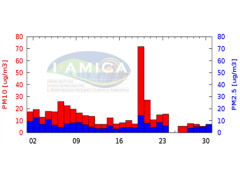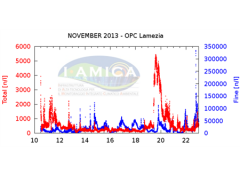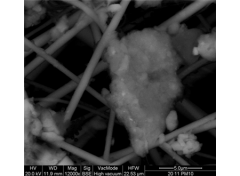FIRST EVIDENCE OF VOLCANIC PLUME OBSERVED AT THE I-AMICA CLIMATE OBSERVATORY OF LAMEZIA TERME
j F Y in In Evidenza
FIRST EVIDENCE OF VOLCANIC PLUME OBSERVED AT THE I-AMICA CLIMATE OBSERVATORY OF LAMEZIA TERME
The first results of the volcanic eruption of Mount Etna on the night between 16 and November 17, 2013, will be presented to “DUST 2014, the International Conference on Atmospheric Dust”, which will be held in Castellana Marina (Ta) , 1-6 June 2014.
In the night between 16 and 17 November 2013, a long duration eruption has affected the SE crater of Mount Etna, resulting in emission of gases and aerosols of volcanic origin. Atmospheric circulation carried the eruption column towards NE. Two days later, on November 19, the I-AMICA CNR-ISAC Climate Observatory located in Lamezia Terme, 500 m from the Tyrrhenian coastline, recorded values PM10 ten times higher than the averaged values, as reportedi in Fig.1.
 Fig. 1 PM10 and PM2.5 values measured at Lamezia Terme in November 2013.
Fig. 1 PM10 and PM2.5 values measured at Lamezia Terme in November 2013.
The analysis of three-dimensional backtrajectories (Hysplit model) with the end point in Lamezia Terme, together with meteorological forecasts by MOLOCH (MOdello LOCale in H coordinates) confirm the possible origin of the sampled aerosol from Mount Etna volcanic plume.

The aerosol size distribution observed shows that the main increase was due to the coarse fraction, which is generally attributed to particles mechanically originating (sea spray, mineral dust minerals from deserts, volcanic ash) . In figure 2 it is clearly visible the increase of the fraction of particles with diameter larger than 1 μm.
Figure 2. Fine and total particles behaviour at Lamezia Terme Observatory in November 2013.
SEM – EDX analyses on filters sampled at Lamezia Observatory and performed at the Department DIBEST University of Calabria found, especially on 19 November, the presence of sulfur-rich  minerals (eg gypsum) with silicates, as well as Halite, lime and organic particles also recorded the day before and after. The composition of the particles analyzed is therefore compatible with the possible volcanic origin of the observed particles, confirmed by fragments of ash and salts formed by the condensation of the gas in the plume. Figure 3 shows one of the silicate particles detected by electron microscopy, probably resulting from solidification of magma fragments. Gypsum, sulfates, sulfur are probably sublimated salts formed by condensation of the erupted gases.
minerals (eg gypsum) with silicates, as well as Halite, lime and organic particles also recorded the day before and after. The composition of the particles analyzed is therefore compatible with the possible volcanic origin of the observed particles, confirmed by fragments of ash and salts formed by the condensation of the gas in the plume. Figure 3 shows one of the silicate particles detected by electron microscopy, probably resulting from solidification of magma fragments. Gypsum, sulfates, sulfur are probably sublimated salts formed by condensation of the erupted gases.
Figure 3. SEM – EDX image of a silicate particle sampled November 20, 2013.
The first results will be presented at “DUST 2014, the International Conference on Atmospheric Dust” that will held in Castellana Marina (Ta) from 1 to 6 of June 2014.
The CNR Climate Observatory of Lamezia Terme is funded within the Project “Infrastructure of High Technology for Environmental and Climate Monitoring” (I-AMICA, PON03-00363) by the Italian National Operative Program (PON) and European Regional Development Fund. The position of the Observatory allows to investigate the variability of natural emissions, such as sea-spray aerosols, mineral dust (i.e., from Sahara desert), as well as of volcanic activities of Etna (about 170 km SSW from Lamezia) and Stromboli (about 85 km).






